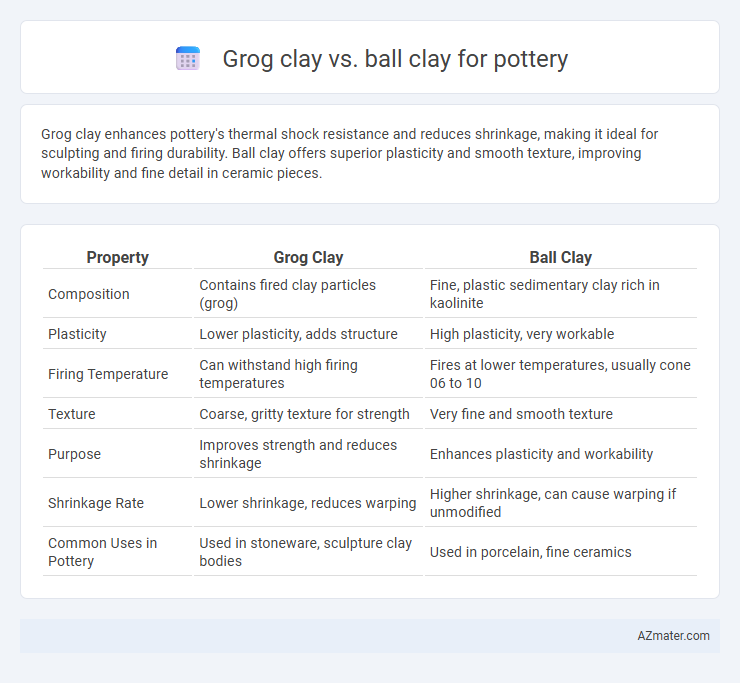Grog clay enhances pottery's thermal shock resistance and reduces shrinkage, making it ideal for sculpting and firing durability. Ball clay offers superior plasticity and smooth texture, improving workability and fine detail in ceramic pieces.
Table of Comparison
| Property | Grog Clay | Ball Clay |
|---|---|---|
| Composition | Contains fired clay particles (grog) | Fine, plastic sedimentary clay rich in kaolinite |
| Plasticity | Lower plasticity, adds structure | High plasticity, very workable |
| Firing Temperature | Can withstand high firing temperatures | Fires at lower temperatures, usually cone 06 to 10 |
| Texture | Coarse, gritty texture for strength | Very fine and smooth texture |
| Purpose | Improves strength and reduces shrinkage | Enhances plasticity and workability |
| Shrinkage Rate | Lower shrinkage, reduces warping | Higher shrinkage, can cause warping if unmodified |
| Common Uses in Pottery | Used in stoneware, sculpture clay bodies | Used in porcelain, fine ceramics |
Introduction to Grog Clay and Ball Clay
Grog clay contains pre-fired clay particles that enhance thermal shock resistance and improve drying shrinkage in pottery, making it ideal for sculpting and large vessel construction. Ball clay, composed primarily of kaolinite, offers high plasticity and fine particle size, which contributes to smooth surfaces and strong green strength in ceramic works. Both clays serve distinct functional purposes: grog clay for structural durability and ball clay for workability and finishing quality in pottery.
Composition and Mineral Content
Grog clay contains crushed fired clay particles, primarily composed of kaolinite, quartz, and mica, which enhance thermal shock resistance and reduce shrinkage in pottery. Ball clay is rich in kaolinite and illite minerals, with fine particle size, contributing to plasticity and workability but higher shrinkage rates. The coarse, alumina-rich grog contrasts with the finer, organic-rich ball clay, impacting texture and firing characteristics in ceramic production.
Physical Properties Comparison
Grog clay contains pre-fired particles that improve thermal shock resistance and reduce shrinkage during firing, making it ideal for heavier, durable pottery. Ball clay, with its finer particles and higher plasticity, offers superior workability and smooth texture but is more prone to higher shrinkage and lower thermal resistance. These distinct physical properties influence the choice of clay depending on the desired pottery strength, texture, and firing characteristics.
Workability on the Potter’s Wheel
Grog clay contains pre-fired clay particles that improve workability on the potter's wheel by providing texture and reducing shrinkage, making it less prone to warping and cracking during drying and firing. Ball clay has a fine, smooth texture with high plasticity, enabling excellent moldability and detail but can be more prone to slumping without added grog or temper for support. Combining grog clay with ball clay often results in balanced workability, allowing potters to achieve both strength and fine detail while maintaining ease of shaping on the wheel.
Drying and Shrinkage Rates
Grog clay contains pre-fired clay particles that reduce drying time and minimize shrinkage, making it ideal for pottery requiring dimensional stability. Ball clay, known for its fine particle size and high plasticity, exhibits higher shrinkage rates and longer drying periods, which can lead to cracking if not carefully managed. Selecting grog clay improves workability and drying performance, while ball clay enhances plasticity but demands controlled drying to avoid deformation.
Firing Temperatures and Results
Grog clay contains pre-fired clay particles that increase thermal shock resistance and reduce shrinkage in pottery, making it ideal for high firing temperatures above 1200degC, such as stoneware and porcelain. Ball clay, characterized by its fine particle size and high plasticity, fires at lower temperatures between 900degC and 1100degC, yielding smooth, dense surfaces but increased shrinkage and potential warping. Using grog clay improves structural strength and texture in fired pots, while ball clay enhances workability but requires careful temperature control to avoid deformation.
Texture and Surface Finish
Grog clay contains pre-fired clay particles that enhance texture by adding grit and reducing shrinkage, resulting in a rougher surface finish ideal for functional or rustic pottery. In contrast, ball clay is highly plastic with fine particles that create a smooth, silky texture after firing, producing a glossy and refined surface finish preferred for delicate or detailed ceramic works. The choice between grog and ball clay directly influences the tactile quality and visual appeal of the final pottery piece.
Strength and Durability
Grog clay enhances pottery strength and durability by incorporating pre-fired, crushed ceramic particles that reduce shrinkage and prevent cracking during firing. Ball clay, known for its fine particles and plasticity, offers excellent workability but can result in weaker, more brittle finished pieces if not properly balanced. Potters often blend grog clay with ball clay to achieve optimal structural integrity and long-lasting durability in ceramic products.
Best Uses in Pottery Applications
Grog clay is ideal for pottery requiring high thermal shock resistance and structural strength, making it perfect for functional ware such as plates, mugs, and teapots that undergo frequent heating and cooling. Ball clay, known for its fine particle size and plasticity, is best suited for detailed casting, slip applications, and smooth surface finishes in decorative and refined ceramics. Combining grog clay with ball clay enhances workability and durability, optimizing performance in both wheel-throwing and hand-building techniques.
Choosing Between Grog Clay and Ball Clay
Choosing between grog clay and ball clay for pottery depends on the desired texture and firing properties. Grog clay contains pre-fired clay particles that improve strength, reduce shrinkage, and enhance thermal shock resistance, making it ideal for sculptural and functional pieces requiring durability. Ball clay offers fine particles and high plasticity, providing excellent workability and smooth finishes but shrinks more during firing, making it better suited for detailed, delicate ceramics and porcelain blends.

Infographic: Grog clay vs Ball clay for Pottery
 azmater.com
azmater.com